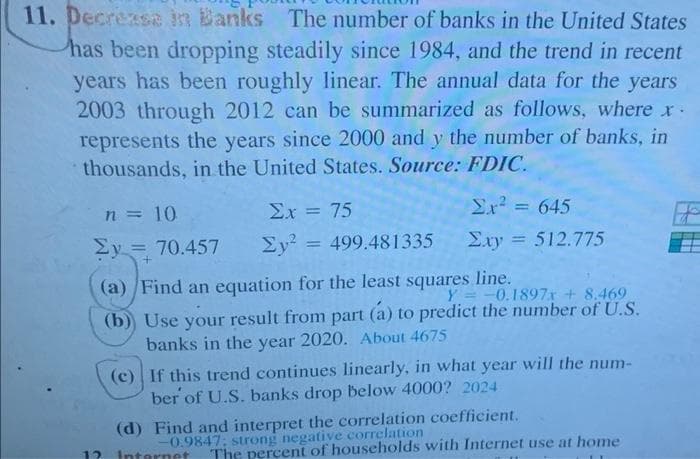11. Decrease in Banks The number of banks in the United States has been dropping steadily since 1984, and the trend in recent years has been roughly linear. The annual data for the years 2003 through 2012 can be summarized as follows, where x. represents the years since 2000 and y the number of banks, in thousands, in the United States. Source: FDIC. n = 10 Ex = 75 Er = 645 %3D %3D Ey = 70.457 Ey? = 499.481335 Exy = 512.775 %3D %3D (a) Find an equation for the least squares line. Y = -0.1897r + 8.469 (b) Use your result from part (a) to predict the number of U.S. banks in the year 2020. About 4675 (c) If this trend continues linearly, in what year will the num- ber of U.S. banks drop below 4000? 2024 (d) Find and interpret the correlation coefficient. -0.9847: strong negative correlation The percent of households with Internet use at home
11. Decrease in Banks The number of banks in the United States has been dropping steadily since 1984, and the trend in recent years has been roughly linear. The annual data for the years 2003 through 2012 can be summarized as follows, where x. represents the years since 2000 and y the number of banks, in thousands, in the United States. Source: FDIC. n = 10 Ex = 75 Er = 645 %3D %3D Ey = 70.457 Ey? = 499.481335 Exy = 512.775 %3D %3D (a) Find an equation for the least squares line. Y = -0.1897r + 8.469 (b) Use your result from part (a) to predict the number of U.S. banks in the year 2020. About 4675 (c) If this trend continues linearly, in what year will the num- ber of U.S. banks drop below 4000? 2024 (d) Find and interpret the correlation coefficient. -0.9847: strong negative correlation The percent of households with Internet use at home
Glencoe Algebra 1, Student Edition, 9780079039897, 0079039898, 2018
18th Edition
ISBN:9780079039897
Author:Carter
Publisher:Carter
Chapter4: Equations Of Linear Functions
Section4.5: Correlation And Causation
Problem 15PPS
Related questions
Question
100%

Transcribed Image Text:11. Decrease in Banks The number of banks in the United States
has been dropping steadily since 1984, and the trend in recent
years has been roughly linear. The annual data for the years
2003 through 2012 can be summarized as follows, where x-
represents the years since 2000 and y the number of banks, in
thousands, in the United States. Source: FDIC.
n = 10
Ex = 75
Ex = 645
%3D
Ey = 70.457
Ey? = 499.481335 Exy = 512.775
(a) Find an equation for the least squares line.
Y = -0.1897r + 8.469
(b) Use your result from part (a) to predict the number of U.S.
banks in the year 2020. About 4675
(c) If this trend continues linearly, in what year will the num-
ber of U.S. banks drop below 4000? 2024
(d) Find and interpret the correlation coefficient.
0.9847: strong negative correlation
The percent of households with Internet use at home
Expert Solution
This question has been solved!
Explore an expertly crafted, step-by-step solution for a thorough understanding of key concepts.
This is a popular solution!
Trending now
This is a popular solution!
Step by step
Solved in 5 steps with 4 images

Recommended textbooks for you

Glencoe Algebra 1, Student Edition, 9780079039897…
Algebra
ISBN:
9780079039897
Author:
Carter
Publisher:
McGraw Hill

Linear Algebra: A Modern Introduction
Algebra
ISBN:
9781285463247
Author:
David Poole
Publisher:
Cengage Learning


Glencoe Algebra 1, Student Edition, 9780079039897…
Algebra
ISBN:
9780079039897
Author:
Carter
Publisher:
McGraw Hill

Linear Algebra: A Modern Introduction
Algebra
ISBN:
9781285463247
Author:
David Poole
Publisher:
Cengage Learning


Algebra and Trigonometry (MindTap Course List)
Algebra
ISBN:
9781305071742
Author:
James Stewart, Lothar Redlin, Saleem Watson
Publisher:
Cengage Learning

Functions and Change: A Modeling Approach to Coll…
Algebra
ISBN:
9781337111348
Author:
Bruce Crauder, Benny Evans, Alan Noell
Publisher:
Cengage Learning

College Algebra
Algebra
ISBN:
9781305115545
Author:
James Stewart, Lothar Redlin, Saleem Watson
Publisher:
Cengage Learning